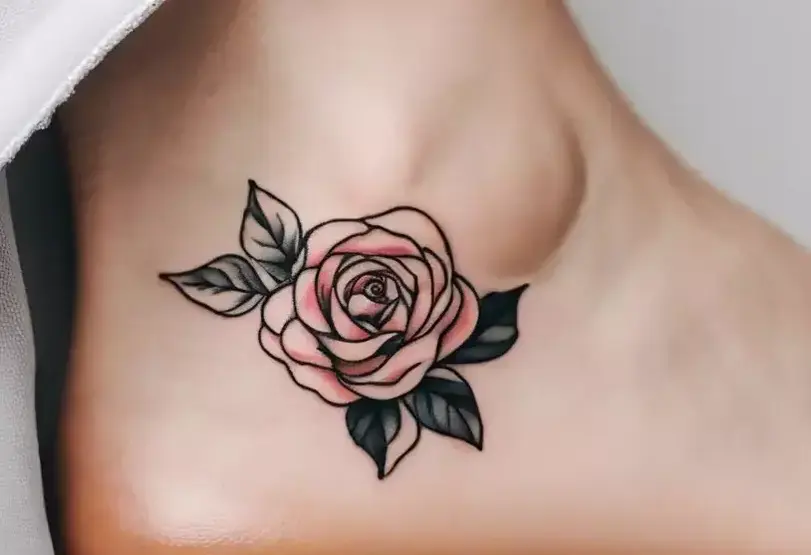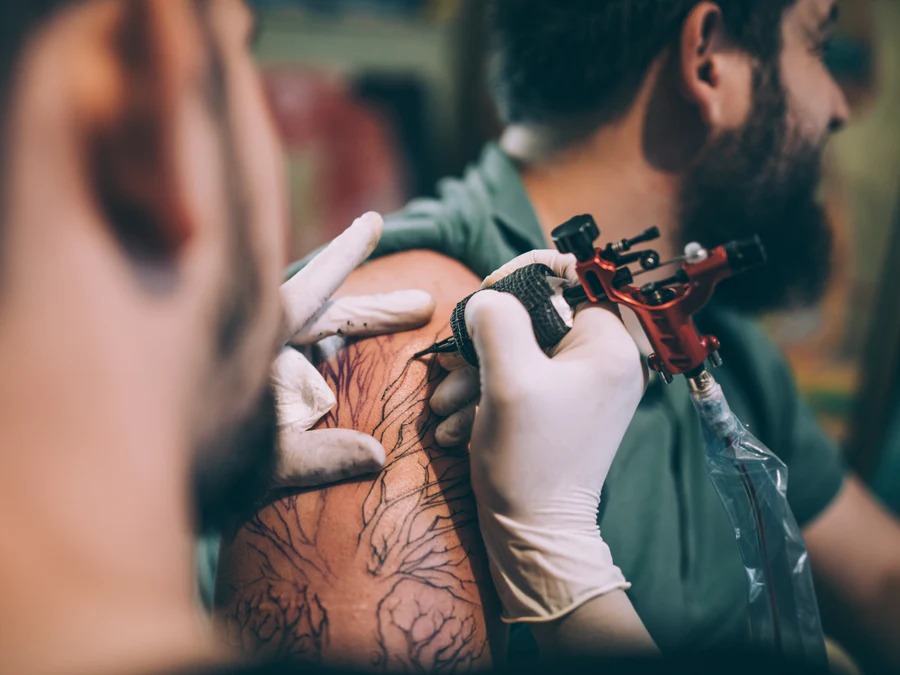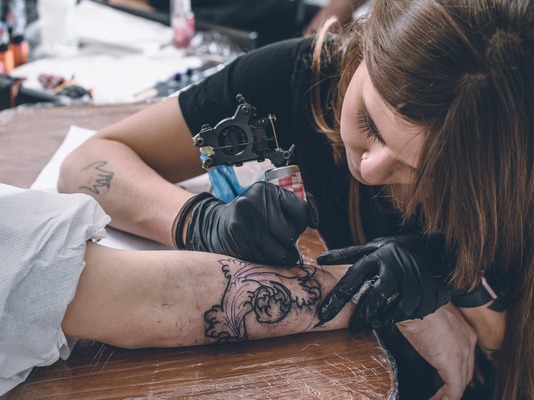Ankle tattoos are a great entry point for those new to the ink scene. They are typically simple, inexpensive, and more painless than other body parts, but proper aftercare is very important. Designs vary by location: a small design on the ankle bone, a medium-sized one that wraps around the ankle, or larger pieces extending to the feet.
Common designs include flowers, a word or saying, butterflies, and barbwire. When visiting a reputable artist, an ankle tattoo may cost $50-$300 depending on size and style. Because these designs are small, they tend to hurt less and for a shorter time. After getting your sleek, stylish piece, it’s crucial to protect it and properly care for it to keep it fresh.
When you get home
After leaving the studio with your new ink covered in a thin layer of petroleum jelly or Vaseline, and wrapped with a bandage to protect your skin from immediate infection, it’s important to follow the right steps for aftercare. When you get home, kick your feet up and apply ice to the area to reduce blood flow and limit swelling.
Ankle tattoos tend to swell more because blood flows downwards when you’re on your feet. Elevate and ice to avoid major swelling. Watch Netflix, play video games, or listen to music for a couple of hours while your body begins to heal. Leave the initial bandage on for at least 24 hours after your session, then start your routine aftercare.
How to clean Ankle Tattoo-The Answer
[su_note note_color=”#D3D3D3″ radius=”6″]Care for your ankle tattoo by washing it twice daily with warm water and fragrance-free antibacterial liquid soap. Ensure to cleanse after exposure to sweat or contaminants, using pump soap to avoid irritation and bacterial accumulation.[/su_note]

How to clean
To care for your ankle tattoo, start by cleaning it with warm water and fragrance-free, antibacterial liquid soap. Wash your hands first, then gently rub the soap in a circular motion with your fingers. Remove any slimy plasma to prevent scabs that could damage your new ink. Clean your tattoo in the morning and before bed, and immediately if it contacts sweat or an infectant. Use a pump soap to prevent irritations and infections. Avoid moisturizing soaps, exfoliating scrubs, and bar soaps as they can irritate and collect bacteria.
How to moisturize
What to apply
For ankle tattoo aftercare, use a scent-free or fragrance-free, white cream lotion or moisturizer to hydrate the skin cells and promote healing. Apply it 3-4x per day. Avoid Aquaphor and Vaseline as they trap too much moisture. Use a do-it-all healing cream directly on the area 1-2x daily to protect and preserve your tattoo.
This cream also relieves pain and itchiness, prevents infections, moisturizes, and keeps your tattoo looking vibrant. Don’t stress about lotion, just get a jar of this cream.
Why moisturizing is important
After cleaning, moisturizing is the most important part of the healing process. It encourages skin regeneration, reduces itching and irritation, and creates a healthy environment for your cells to heal the damaged skin. If you don’t moisturize at least 2-3x per day, your skin will dry out, damaging your new tattoo before you can show it off. Dryness slows the cellular healing and opens you up to more infections.
When to moisturize
Apply your daily tattoo moisturizer when the area begins to dry out, usually 24 hours after your session. Clean the area after removing the initial bandage and moisturize immediately after the first cleaning session. Use lotion 3-5x per day for the first two weeks, then continue as part of your daily skincare regimen. With daily cleaning and moisturizing, your skin and ink will heal quickly.
Other things to keep in mind
Can I wear socks or shoes after getting an ankle tattoo?
After getting an ankle tattoo, avoid socks or shoes that cover it. Tight jeans or pants can rub against your skin, causing friction that may damage and fade the tattoo. They can also trap heat and moisture, creating an ideal environment for bacteria to grow and infect your body.
If the tattoo is high on your leg, wear low-rise socks and shoes that don’t touch the area. Otherwise, it is advisable to wear sandals or flip-flops. If the tattoo extends to your foot, capris, yoga pants, or cuffed pants are fine. When in doubt, wear shorts.
When to get an ankle tattoo
Since you can’t wear socks, pants, or shoes for the first 2-3 weeks after getting a tattoo, it’s best to do it in the summer. This way, your ankle can breathe freely and you won’t worry about your feet or legs getting cold in the winter.
Where sunscreen
If you schedule your tattoo in the summer, it’s important to cover it with sunscreen when you’re outside. UV exposure can fade, crack, or blister your tattoo. Be sure to use plenty of sunscreen. It’s best to completely avoid the sun for 3-4 weeks after your session, but if that’s not possible, use a broad-spectrum, fragrance-free sunscreen with 30-50 SPF.
Avoid artificial ingredients that can irritate your skin. Choose organic options or those with zinc oxide or titanium oxide, which are non-toxic according to the FDA.
Stay out of the water
To protect your tattoo, avoid pools, lakes, and oceans for the first few weeks. Chlorine pools aren’t sanitary, and you risk infecting the healing skin, causing permanent damage. Chemicals can negatively affect the color, vibrance, and appearance of your tattoo. If at the beach, keep your feet out of the water and cover the area with a waterproof bandage and sunscreen.
If it gets wet, clean and moisturize the area immediately. While showering, use cool water instead of hot to avoid burning. Refrain from using a loofah or washcloth as they create friction and may harbor bacteria.
Don’t itch the ink
Avoid scratching or itching your ankle tattoo to prevent damage. Though it’s easier said than done, resist the urge to scratch your skin. Apply moisturizer to relieve dryness and irritation, ensuring the ink stays intact. Proper care helps keep your tattoo vibrant and healthy.
How long does an ankle tattoo take to heal?
With proper aftercare, the top layer of skin on your ankle tattoo should heal within 2-4 weeks, depending on the size, location, and your commitment to the healing process. You can start wearing shoes and socks regularly, but keep up your standard routine.
Tattoo ink penetrates deep into your skin, so even if it looks healed on the outside, the inner layers may take upwards of six months to fully heal. Sun exposure and infections can delay this process. If you follow these steps and take care of your new masterpiece, you’ll be healed and back on your feet in no time.
Frequently Asked Question
Can I walk after an ankle tattoo?
After getting an ankle tattoo, your artist will suggest you wait 48 hours before strenuous physical activity or heavy sweating. This is important to allow the wound to start healing. Generally, it takes 4 to 6 weeks for a tattoo to heal. Avoid pressure on your ankle and keep the area clean to ensure proper healing.
Can you wear shoes with an ankle tattoo?
For ankles, it’s essential to avoid wearing anything that might irritate the area. During the healing process, refrain from wearing socks or shoes that can rub against the tattoo. As Brooklyn-based tattoo artist Carly Jordyn told BI, this can lead to ink loss or even infection. Lawson added that careful attention to these details ensures your tattoo heals beautifully.
Do ankle tattoos hurt a lot?
Ankle tattoos, like those on the shin and feet, are known to be quite painful. These areas are very bony and rank high on the pain scale, often at 9/10. The ultra-thin skin in these spots, combined with several nerve endings and little to no fat covering the bone, makes getting tattoos in these areas particularly intense.
Will ankle tattoos fade?
Around the ankle, sides of feet, top of the foot, toes, and around the heel area are all affected quickly after getting a tattoo. Tattoos in these areas can fade, blow out, and experience complete color loss in spots. You might notice loss of line work from small spots to large gaps. Proper care is essential to minimize these issues.


